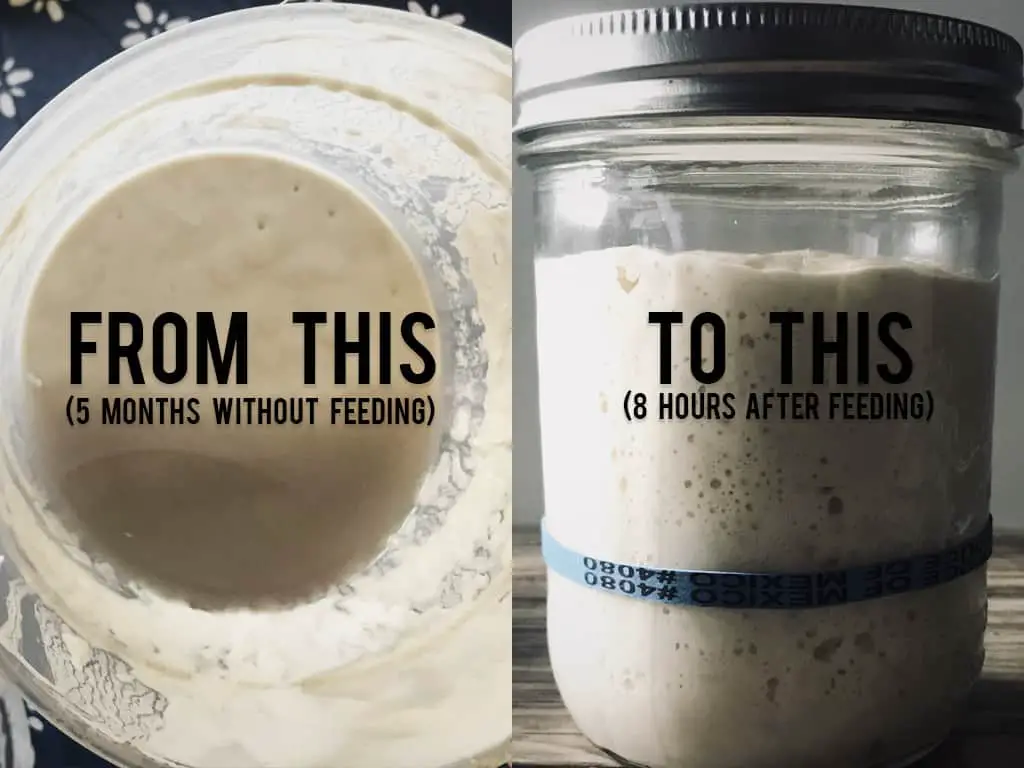
First time starter crust on top. Whether youre feeding 1 TBSP of starter or 4 ounces of starter what matters is that youre adding.

To feed your starter firstly use a clean utensil to remove all but 100g of the starter from the jar.
How much to feed sourdough starter. Did you read through the post and instructions. You feed 4 oz of starter with 4 oz of water and 4 oz of flour. When that is ready and active you can use the amount of starter called for in your recipe.
Then feed the starter again to bring it back to the starting weight 12 oz. Feeding using and refeeding the starter is a cycle. How To Feed Your Sourdough Starter at a Glance Remove and discard half of your sourdough starter Feed whats left in the jar with equal parts flour and water by weight 111 feeding ratio Let rise at room temperature covered or airtight ideally 75.
For a 111 feeding you would feed the 10 grams of starter that you kept with 10 grams of water and 10 grams of flour. This fresh flour and water is not only food for the culture that you kept but it is also now a part of that culture. In this example you would then have 30 grams total starter after your feeding.
First time starter crust on top. This is my first time making sourdough starter and Ive been using a 21 ratio of flour to water. I put my starter in a glass bowl and very loosely covered with a dish towel.
After feeding my starter a day before I went to feed again and discovered a brown crust on top. Almost like it dried up. By activating your starter I simply mean adding flour and water to your starter stirring and waiting patiently which ironically is all there really is to feeding a sourdough starter but I digress.
If youre like me and just want to dive right in then you can purchase a dried starter for as little as 15. How Your Baking Schedule Affects Your Sourdough Starter. Your baking schedule will have a big effect on how often you need to feed your sourdough starter too.
If you only plan on using your starter a couple of times a month for example you wont need to feed your starter nearly as often as you would if you wanted to bake a couple of times a week. You can build a much bigger starter from just a small amount very easily as above - time is the thing that will change. For example - if you had 15g and you wanted 300g - then you would feed your 15g of starter 150g of water and 150g of flour - this way youd have 300g of.
The amount of starter you feed depends on how much bread you usually make but this is the basic formula. To a scant 14 cup 175 ounces49 grams starter add 13 cup 175 ounces49 grams. To feed your starter firstly use a clean utensil to remove all but 100g of the starter from the jar.
Then add 100g flour and 100g water and stir well until evenly combined. Seal the jar and store at room temperature or in the fridge. You now have 300g of starter.
After each feeding the dough needs to ferment and double in volume which takes about 6 to 8 hours. In between feedings keep the starter covered and at room temperature. Sourdough Feeding Instructions Measure room temperature starter or remove ¼ cup starter from refrigerator.
Feed the starter with flour and water every 8-12 hours using one of the following methods. If using a scale to measure ingredients combine equal amounts by weight of starter water and flour. To feed a sourdough starter using weight simply combine equal parts starter flour and water.
For example 100 grams of each. Or for a larger starter 200 grams of each. With this method it is very helpful to.
Most sourdough starter has a 100 hydration level meaning its made up of a 11 ratio of flour to water. Whether youre feeding 1 TBSP of starter or 4 ounces of starter what matters is that youre adding. On the fifth day of feeding once your starter is consistently showing signs of fermentation 24 hours after being fed it is ready to use.
Follow our sourdough recipe to make the perfect sourdough loaf. Continue to feed your starter in between bakes and only store in. After 6 hours more or less repeat the process.
Discard most of it and feed it with 40 g each flour and water. Once you have a strong starter on hand one that is doubling in volume within 4 to 6 hours.